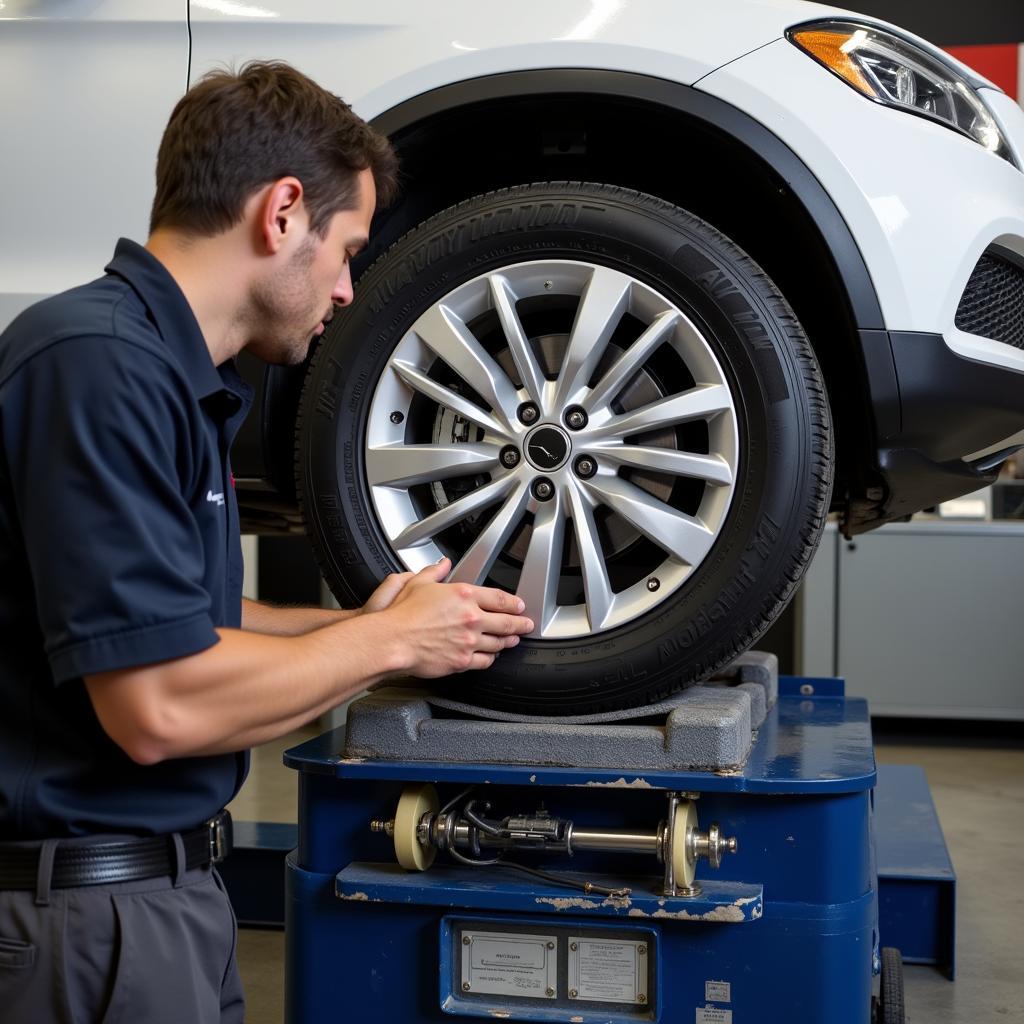Car Tire Balance Problems can lead to a bumpy ride, premature tire wear, and even damage to your vehicle’s suspension. Understanding the causes, symptoms, and solutions is crucial for maintaining your car’s performance and safety. This article provides a deep dive into everything you need to know about car tire balance issues.
Balancing your car tires is crucial for a smooth and safe driving experience. A slight imbalance can cause vibrations, uneven tire wear, and reduced fuel efficiency. But what exactly causes these imbalances, and how can you identify and fix them? Let’s explore the world of car tire balance problems.
Understanding Car Tire Balance
Tire imbalance occurs when the weight distribution around the tire and wheel assembly is uneven. This unevenness creates centrifugal force at higher speeds, leading to vibrations that you can feel through the steering wheel, floorboard, or even the seats. There are two main types of tire imbalance: static and dynamic.
Static Imbalance: The Wobble Effect
Static imbalance is when the weight is unevenly distributed on one side of the tire. Think of it like a seesaw that’s heavier on one side. This type of imbalance causes the tire to wobble or hop, especially noticeable at lower speeds.
 Static Tire Imbalance
Static Tire Imbalance
Dynamic Imbalance: The Shimmy and Shake
Dynamic imbalance happens when the weight is unevenly distributed along the circumference of the tire. This creates a side-to-side wobble, often referred to as a shimmy or shake, which becomes more pronounced at higher speeds.
What Causes Car Tire Balance Problems?
Several factors can contribute to car tire balance problems. Common causes include:
- Loss of wheel weights: These small weights are attached to the wheel rim to counterbalance heavy spots on the tire. Over time, they can fall off due to impacts from potholes or curbs.
- Uneven tire wear: Improper inflation, misalignment, or worn suspension components can lead to uneven tire wear, creating an imbalance.
- Tire damage: Potholes, impacts with curbs, or punctures can damage the tire’s internal structure, affecting its weight distribution.
- Improper tire repair: An improperly patched tire can also create an imbalance.
Identifying Car Tire Balance Issues
Recognizing the signs of tire imbalance is key to addressing the issue promptly. Here are some telltale symptoms:
- Vibration in the steering wheel: This is often the first sign of a tire balance problem, especially noticeable at speeds between 50 and 70 mph. If your steering wheel vibrates while driving, there could be several reasons, including tire balance issues. You can find more information on this topic in our article on car problems vibration steering wheel.
- Vibration in the floorboard or seats: As the imbalance worsens, the vibrations can become more pronounced and felt throughout the vehicle.
- Uneven tire wear: Look for signs of uneven wear patterns on the tire tread, such as cupping or scalloping.
- Reduced fuel economy: Imbalance creates extra rolling resistance, forcing your engine to work harder and consume more fuel.
- Premature tire wear: Vibrations can accelerate tire wear, shortening their lifespan.
How to Fix Car Tire Balance Problems
The most effective way to fix a tire balance problem is to have a tire professional perform a wheel balancing service. This involves mounting the tire and wheel assembly on a balancing machine, which spins it to identify the location and amount of imbalance. The technician then attaches corrective weights to the wheel rim to counterbalance the heavy spots.
 Tire Balancing Machine
Tire Balancing Machine
Preventing Car Tire Balance Problems
While you can’t entirely prevent tire imbalance, you can take steps to minimize the risk:
- Regular tire rotations: Rotating your tires every 5,000 to 8,000 miles helps to promote even wear and prevent imbalances from developing.
- Proper tire inflation: Maintain the correct tire pressure as recommended by your vehicle manufacturer.
- Wheel alignment: Regular wheel alignments ensure that your tires are properly aligned and wear evenly. For example, a car on a turn experiences problems with max velocity due to various factors, and addressing these issues is crucial for performance. Learn more about car on a turn problem max velocity.
- Regular vehicle maintenance: Have your suspension components inspected and repaired or replaced as needed to prevent uneven tire wear. This is especially important for vehicles prone to specific problems, like those discussed in our article on genesis car problems.
Conclusion
Car tire balance problems can significantly impact your driving experience, tire life, and overall vehicle performance. By understanding the causes, symptoms, and solutions, you can proactively address these issues and ensure a smooth, safe, and efficient ride. If you suspect a tire balance problem, don’t hesitate to contact a qualified tire professional for diagnosis and repair. Connect with AutoTipPro at +1 (641) 206-8880 or visit our office at 500 N St Mary’s St, San Antonio, TX 78205, United States, for expert advice and assistance.







Leave a Reply